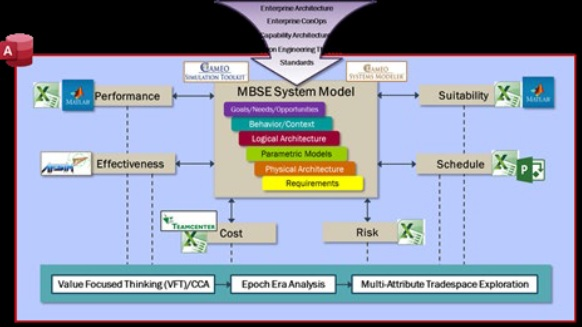Capability Development MBSE Guidebook
The Air Force Strategic Development Planning and Experimentation (SDPE) Office created a Model Based Systems Engineering (MBSE) Guidebook for early capability development that provides knowledge on the application of MBSE to the process of early systems engineering.
This guidebook is the culmination of an effort by the SDPE Office to address a complex, ill-defined process using MBSE and a phased base approach called the Capability Development Process Framework. While this is specific to the early systems engineering problem set, the guidebook addresses digital engineering concepts that a program could use in other acquisition process challenges.
The method begins with a notional assessment of cost and capability for solution types to meet a project goal. Next, promising solution types are down selected and refined into concept types. These concept types are defined and analyzed in terms of notionally assessed Performance, Effectiveness, Risk, Cost, Schedule, and Suitability. Modeling, Simulation, and Analysist tools are coupled with the MBSE system architecture to refine the measures that define a concept’s capability.

Style Guides
The Digital Campaign has also collected several style guides that are in use across multiple programs. While there is no singular style guide for the Department of the Air Force, Space and Missile Center has developed an enterprise level MBSE Style Guide. The SSC Style Guide is written as a general style guide that can be applied beyond the space domain. The AF Digital Campaign recommends the utilization of a style guide to establish validation rules that will enable and verify proper MBSE model development.
The SSC style guide could parlay into more specific program MBSE guides without breaking the top-level validation rules. The style guide can be used to provide a “quality” measure for accepting deliverables from contractors.
If you are a program that has already a developed style guide we are interested in receiving a copy. Please send to [email protected] <mailto:[email protected]>.
Contact
NON-DOD: Please Contact [email protected] <mailto:[email protected]> to request more information or a copy of the SDPE MBSE Guidebook or SSC Style Guide.
Requests from a non-.MIL address will need to come from a government sponsor due to current Distribution restrictions.
DOD can access these resources on the internal AFMC Digital Guide.
Note: SSC Style Guide V 1.0 is currently in final review, and is expected to be released as Distro A. More details will be posted here as it becomes available.
